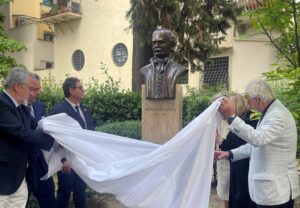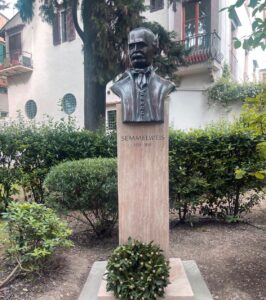
This brings the number of officially recognized unique cultural features and items in Hungary to 96.Continue reading

The statue of Ignaz Semmelweis, known as the savior of mothers, was unveiled by Béla Merkely, rector of Semmelweis University, in Florence on Wednesday afternoon in the garden of the Ospedale degli Innocenti, known as Europe’s oldest orphanage and child protection center.

Unveiling of the statue in the Ospedale degli Innocenti. Photo: MTI
After the unveiling, Béla Merkely told MTI, “It is the duty of doctors to make new discoveries in their field, find solutions to difficulties, and improve the quality of life of patients.”
Ignác Semmelweis is a role model for us in this regard, and now we have brought this role model to Florence,”
he said.
The ceremonial unveiling was attended by Ádám Zoltán Kovács, Hungary’s ambassador to Rome, Krisztina Lantos, director of the Hungarian Academy in Rome, Erika Emma Fodré, Vice President of the Italian-Hungarian Association, László Rosiwall, President of the Semmelweis Memorial Committee, and Sabrina Breschi, CEO of Ospedale degli Innocenti. The work was officially accepted by Maria Grazia Giuffrida, President of the Istituto degli Innocenti, which maintains the building, and then unveiled by the rector of Semmelweis University.
The statue of Ignác Semmelweis was placed in the inner courtyard of the building, where children and parents attending the institution pass by every day. Members of the Hungarian communities in Florence and Rome also attended the statue unveiling ceremony.
The work of Kossuth Prize-winning sculptor István Madarassy is the twenty-seventh Semmelweis statue, which Semmelweis University is donating to renowned institutions with the support of the Hungarian Government. This is the second statue in Italy; the first was erected in 2023 in Perugia, at the Santa Maria della Misericordia Hospital, which is affiliated with the city’s medical university.
As a result of the work of Semmelweis University and the Semmelweis Memorial Committee, statues erected on four continents around the world pay tribute to the Hungarian doctor’s work, scientific legacy, and revolutionary discoveries in the field of medicine.

Statue of Ignaz Semmelweis, known as the savior of mothers, in Florence, in the garden of the Ospedale degli Innocenti, known as Europe’s oldest orphanage and child protection center. The statue is the work of sculptor István Madarassy. Photo: MTI
Founded in 1419, the Ospedale degli Innocenti, or “hospital of the innocents,” has served its original purpose for more than six hundred years. During the Renaissance, it began operating as Europe’s first orphanage and children’s home: the rotating cradle in which unwanted babies were placed can still be seen on the street front of the building today. By 1875, more than half a million children had been admitted.
Today, the institution is still involved in child and family protection, operating a municipal nursery and kindergarten, as well as providing safe accommodation for dozens of parents and their children. In addition, it also houses a pediatric research center.
The Ospedale degli Innocenti is considered one of the gems of the Florentine Renaissance, as the greatest painters, architects, and sculptors of the time contributed to its beautification, including Botticelli, Ghirlandaio, and later Borromini, who created the arcade of the former infirmary.
Fact
Ignaz Philipp Semmelweis (Semmelweis Ignác), 1818-1865, was a Hungarian physician and scientist who was an early pioneer of antiseptic procedures and was described as the “saviour of mothers,” Childbed fever consists of any bacterial infection of the reproductive tract following birth and in the 19th century was common and often fatal. Semmelweis discovered that the incidence of infection could be drastically reduced by requiring healthcare workers to disinfect their hands. In 1847, he proposed hand washing with chlorinated lime solutions at Vienna General Hospital’s First Obstetrical Clinic, where doctors’ wards had three times the mortality of midwives’ wards. The maternal mortality rate dropped from 18% to less than 2%, and he published a book of his findings, Etiology, Concept and Prophylaxis of Childbed Fever, in 1861.
Featured Image: Pixabay